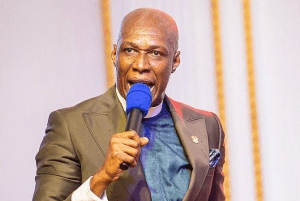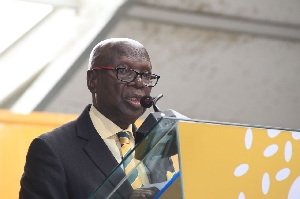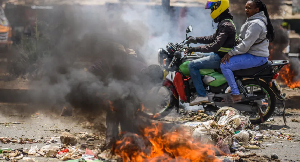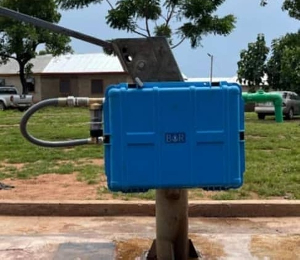Just as I was putting finishing touches to the first instalment of this piece, news came through that the Ghana Railway Company Limited (GRCL) had suspended plans to transport people from Accra to Tema and Accra to Nsawam free of charge due to encroachment. GRCL had planned to begin the much-touted free ride on Tuesday, January 8, 2019.
The company then set January 19, 2019 as the new date for the test run of the passenger train service from Accra to Tema which was suspended on October 27, 2017 following the derailment of a train at Alajo, a suburb of Accra.
However, a statement issued by the management of GRCL on Tuesday, January 8, 2019 in Accra said the suspension had been necessitated by encroachment observed at the Kwame Nkrumah Circle, Avenor and Achimota.
The statement indicated that the Minister of Railway Development, Mr Joe Ghartey, and management of GRCL, made the observation when they visited the areas on Monday night (i.e January 7) to get first-hand information.
According to the statement, “The encroachers ostensibly returned to the lines when GRCL workers went on Christmas break.”
It added that “while dealing with the encroachers to make the lines safe, management of GRCL has taken insurance cover for all passengers who patronise the trains and also put in place mechanisms to ensure passenger safety and comfort”.
Following the announcement that the free ride from Accra to Tema had been fixed for Saturday, January 19, 2019, I decided to drive to the Accra Railway Terminal the following day, Saturday, January 20, to see things for myself and to find out if the test run came on the day before.
Familiar terrain
The Accra Railway Terminal is a well-known terrain of mine. Until about six months ago when I stopped going to the Central Business District (CBD) of Accra. It was one of three places I used to park my car at weekends to walk across to Okaishie and Makola. The other place I use is the car park of the NIB, opposite the Railway Terminal, which has very good security.
For many years, I have been praying always at the mosque inside the Kinbu office of the Ghana Education Service. So on Fridays I find it convenient to park at Kinbu which is not too far from the Railway Terminal.
Many friends of mine always tell me that area of Accra is a no-go area for them. They tell me they can’t just imagine looking for a place in that part of the Central Business District to park their cars and walk about looking for something to buy.
But that area has been a familiar terrain of mine since my secondary school days at the West Africa Senior High School (WASS) in the early 60s.
So that Sunday I drove all the way from Gbawe to the Accra Railway Terminal. As I entered the yard I realised that it had a new look. The car park of the terminal had been regravelled and there was not a single vehicle at the park which used to be jammed only a few months ago, with motorists finding the place convenient to park their vehicles while they do some marketing or whatever at the CBD.
The old colonial building that used to serve as offices of the railway company was its good old self, only that it had been freshly painted, making it look new.
However, it was still the same building where as students from WASS going home on holidays we used to pass through in the early 60s with our trunks and boxes.
The whole place was quiet, a far cry from the market place it had been turned into until the New Patriotic Party (NPP) government announced the rehabilitation of the railway sector. I couldn’t find those destitutes who had made the place their home since the railway sector collapsed some years back.
As I tried to take a look at the refurbished station, a young man who claimed to be the security man in charge, approached me and asked if he could be of assistance.
After exchanging some pleasantries, I asked him if the test run scheduled for the day before came on. He answered in the negative, explaining that the problem was with the tracks from Kwame Nkrumah Circle and beyond which had been encroached upon by traders, making any movement by train impossible.
He told me the terminal had been cleared of all encroachers and the railway tracks rehabilitated but that the problem was with the tracks from Circle to Avenor.
After taking another look at the rehabilitated tracks at the terminal I thanked the security man and left. As we drove over the overhead bridge on the Graphic road with my driver I looked to my right and realised that work was still going on to drive away the encroachers at Circle.
My dear readers, as I mentioned in the first instalment of this piece published last week, the major problem facing the railway sector is encroachment of the tracks from Accra to Kumasi and from Kumasi to Sekondi.
I have always wondered if rehabilitating the old tracks is the solution to the problem of revamping the railway sector or building new tracks altogether so that we can have fast moving trains on new tracks with the standard gauge instead of the narrow gauge.
Why not a new one?
If our colonial masters were able to construct the railway lines from the closing years of the 19th century to the early years of the 20th century using local labourers and workers, with some imported from Nigeria, why can’t we abandon the old tracks and build new ones for the 21st century?
Whether constructing new tracks or rehabilitating the old lines is capital intensive. As one of my readers wrote to me last week the present government should not think of completing the entire project only during its tenure but then any new government coming in should be compelled to continue with the project since it is a national project from which the entire citizenry, including those unborn, could benefit. That is how to build a nation.
There must be continuity so that a major project started by one government must be completed by another, like a relay race.
Ghana and Nigeria are linked by history, being under the same British rule till independence in 1957 and 1960 respectively. The railways in the two countries were constructed during the same period, with Nigeria having a broader network, terminating in the North, especially Kano.
Governor Guggisberg wanted the railway in the Gold Coast to reach Paga, but for reasons unknown that target was never achieved.
The railways in Nigeria have faced similar problems but have been completely overhauled only recently with new tracks. Why can’t we do the same by learning from Nigeria? Can’t we pull down the old terminal building in Accra and build a new one and do same in some of the old stations such as Nkawkaw, Koforidua, Konongo etc?
We need a modern railway system.
Opinions of Sunday, 27 January 2019
Columnist: Razak El-Alawa





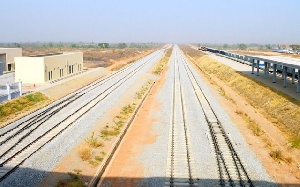

![Ibrahim Mahama [L] and Okatakyie Afrifa-Mensah Ibrahim Mahama [L] and Okatakyie Afrifa-Mensah](https://cdn.ghanaweb.com/imagelib/pics/352/35297352.295.jpg)

